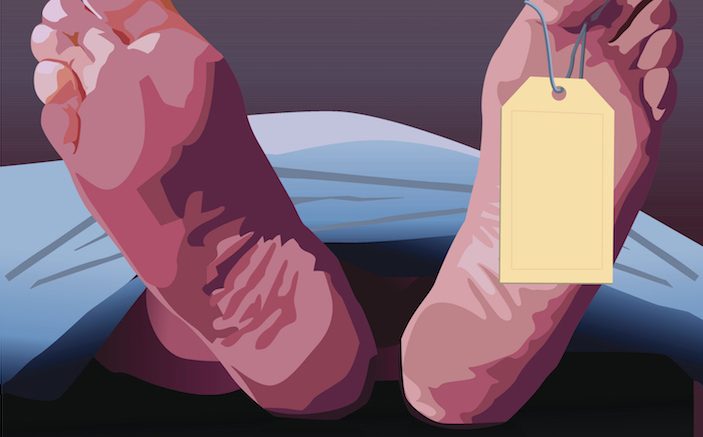There was a nearly 50% decrease in adult mortality in the ED between 1997 and 2011. A new study explores why.
The Emergency Department (ED) is far from an ideal place to die. Yet over half of elderly adults in the United States visit the ED in their final month of life. ED visits ending in death are trying for everyone involved – patients, caregivers, and providers alike – and also represent significant costs to the health care system. Ideally, we’d want a health care system designed to allow patients to spend their final hours with their loved ones, in an environment that facilitates appropriate mourning and palliative care. So, how often are patients actually dying in the chaotic emergency department rather than in this ideal environment?
We, along with Dr. Renee Hsia, addressed this question in a 2016 publication [1] looking at ED adult mortality rates in the United States between 1997 and 2011. Using a dataset available through the Centers for Disease Control and Prevention (CDC), we found something significant. The rate of adult patients dying in the ED dropped by 48% over that time period. In 1997, the death rate was 1.48 per one thousand US adults. This decreased to 0.77 per one thousand US adults in 2011.
Not surprisingly, patients with older age and more acute triage scores were more likely to die in the ED. Nearly two thirds (63%) of the patients who experienced ED death presented in cardiopulmonary arrest, were unconscious, or dead on arrival. For the remaining patients, the most common presenting symptoms were shortness of breath (8%), injury (5%), and chest pain (4%). The mortality rates incorporated population estimates from the US Census Bureau as a denominator, not total ED visits. Thus, the negative mortality trend was not related to the increasing number of low-acuity ED visits.
We can’t say why this downward trend in ED mortality is happening from this study, but there are some possible explanations. First, this trend may be due to the increasing role of palliative care in the United States. Palliative care efforts often result in terminally-ill patients dying in the comfort of their own home or in hospice-type settings. Between 1989 and 2007, there was a more than 50% increase in the proportion of patients dying at home. This could conceivably lead to fewer patients at the end-of-life being transferred to an ED. Second, this trend may be explained by recent efforts in the pre-hospital systems to withhold or terminate resuscitation efforts in futile clinical scenarios. For example, over the past decade, certain cities in the United States implemented pre-hospital policies to forgo resuscitation efforts in certain patients with cardiac arrest, based on specific advanced directives or length of downtime. This would result in fewer patients in cardiac arrest being taken to the ED, where they may be pronounced dead on arrival.
Third, improvements in public health could also help explain the drop in ED mortality rate. For example, improved motor vehicle safety, such as greater enforcement of speed limits and drunk driving laws, could have led to lower ED mortality among blunt trauma patients.
Finally, we can’t discount the possibility that improved emergency medicine is contributing to the decreased death rate. More and more EDs are now staffed by full-time, board-certified emergency physicians specially trained to deal with acute emergencies. More recently, an increasing number of emergency medicine graduates have pursued critical care fellowships, giving them advanced clinical skills to use while treating critically ill patients. There have also been broad advances in the initial management of many acute conditions, with evidence-based protocols for sepsis, stroke, trauma, and acute coronary syndrome, to name a few. All of these developments could potentially contribute to the decrease in ED mortality.
While it is possible that ED patients are simply surviving long enough to be admitted to the hospital, we didn’t see a rise in in-patient mortality rates (available in the same dataset), so this explanation is less likely.
In summary, from the late 90’s to the early part of this decade, adult patient death rates in the ED decreased. The causes underlying this trend are likely multi-factorial, including advances in public health, as well as palliative, pre-hospital, and emergency critical care. Overall, this could suggest possible improvement in our health care system, whereby patients can spend their final hours away from the discomfort of a busy ED in a more appropriate setting. We believe every patient should have the right to peace, quiet, and privacy in their final moments, ideally surrounded by loved ones – and so we find this trend encouraging.

REFERENCE
- http://content.healthaffairs.org/content/35/7/1303.abstract









1 Comment
One thing the author left out was that medicine in general is much better now than it was a couple of decades ago. When I was a paramedic in the 80s it was all too common to have CHF, COPD and asthma patients so decompensated and acidotic that we intubated them on scene. This is far less common with the drugs patients are on today as people are better maintained at home. I do agree that public health efforts have also had an impact – I find our patients are much more aware of the warning signs of stroke, MI and other potentially lethal illnesses than they were back then. Finally, I think the ACS and it’s impact on creating a more organized system of trauma centers has done a ton to improve care in that population.